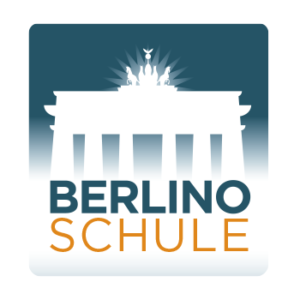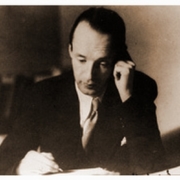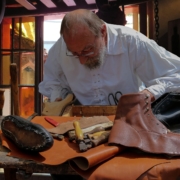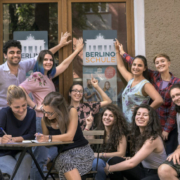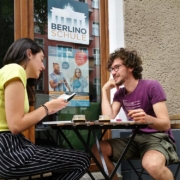The Summer School of Berlino Schule is the study trip you are looking for. If you choose to register for our classes, you will have the possibility to attend super-intensive courses of 5 hours per day (from Monday to Friday) for 2 weeks, in the lively and international district of Friedrichshain
Imagine a day hot as hell. You’re watching TV with your buddy lying on a sofa, while a fan is blowing on a mild breeze. Sweating buckets, pants glued on the pills… you would kill for a cold drink. Out of the blue, your buddy gets up, heading towards the kitchen.
– Fritz Kola oder Club Mate? – he asks while he opens the fridge.
– Eh?!
– Trinkst du lieber ein Bier? –
The TV show you have been watching for hours starts talking in a strange way, it looks German…. What the hell is …
RIIING RIIING! WAKE UP, IT’S TIME TO LEARN GERMAN!
And that’s a Midsummer night’s dream, not a nightmare! Full immersion is the key to unlock the wonderful world of foreign languages, as you can immerge yourself into a new world, practice your skills, taste new food, discover new cultures. And how about doing this super exciting experience during the Summer, in a cool and buzzy city like Berlin? Keep calm and don’t dread the adventure, Übung macht den Meister as Germans say. It’s just practice that makes everything perfect. Close your eyes and imagine to bite a Berliner Pfannkuchen or Franzbrötchen for breakfast, then stroll along the Berliner Mauer, the biggest open-air gallery in the world. You can end up in a colourful Flohmarkt or enjoy a beer in one of the typical German Biergärten.
Let’s chill out and enjoy our Summer School at Berlino Schule!
If you choose to register for one of our super-intensive courses, you will have the opportunity to attend German classes every day (from Monday to Friday) for 2 weeks, in the lively and international district of Friedrichshain.
That’s not all!
Students attending the courses at Berlino Schule will be offered the chance to join extra activities, related to the German language (i.e. cineforum, walking tours, museums, conversation activities, etc) for a total amount of 8 activities per course.
Price
230 €. In case you want to attend two superintensive courses, you will pay 440 instead of 460.
Accomodation
Mission impossible? No panic! Berlino Schule has established some agreements with flats, hostels and hotels to make your studying holiday as easier as possible. If you are interested, you can contact the school and we will provide you with a list containing all the info you need.
Book the whole package!
You would like to attend a super-intensive course, but it is rather difficult for you to find an accomodation? We can provide you with an a single room in some hotels just nearby Berlino Schule (15 nights) and you can have the chance to get 2 weekly tickets (AB zone). Ask for a price quotation!
The dates
Summer School courses will be held from the 8th of July to the 30th of August and will be every 2 weeks: 8-19 July, 22 July-2 August, 5-16 August, 19-30 August, every day, from 14:30 to 18:45. Here you can find the whole calendar.
Summer School’s calendar
ROUND I
A1.1: 8 JULY-19 JULY (14.30 – 18.45)
A2.1: 8 JULY-19 JULY (14.30 – 18.45)
B2.1: 8 JULY-19 JULY (14.30 – 18.45)
ROUND II
A1.2: 22 JULY-2 AUGUST (14.30 – 18.45)
A2.2: 22 JULY-2 AUGUST (14.30 – 18.45)
B2.2: 22 JULY-2 AUGUST (14.30 – 18.45)
ROUND III
A1.1: 5 AUGUST-16 AUGUST (14.30 – 18.45)
B1.1: 5 AUGUST-16 AUGUST (14.30 – 18.45)
C1.1: 5 AUGUST-16 AUGUST (14.30 – 18.45)
ROUND IV
A1.2: 19 AUGUST-30 AUGUST
B1.2: 19 AUGUST-30 AUGUST
C1.2: 19 AUGUST-30 AUGUST
No time for super-intensive courses in the afternoon? Join our evening classes!
Our evening German courses last 8 weeks, for a total amount of 48 hours: classes take place twice a week (Monday and Wednesday or Tuesday and Thursday), 3 hours per day, from 19.15 to 21.40.
Price: 240 euro + 20 euro registration fee
Our German evening courses – May/June
A1.1 6 MAY – 26 JUNE (MON and WED 19.15 – 21.40)
A1.2 7 MAY – 27 JUNE (TUE and THU 19.15 – 21.40)
A2.1 6 MAY – 26 JUNE (MON and WED 19.15 – 21.40)
A2.2 7 MAY – 27 JUNE (TUE and THU 19.15 – 21.40)
B1.1 7 MAY – 27 JUNE (TUE and THU 19.15 – 21.40)
B1.2 6 MAY – 26 JUNE (MON and WED 19.15 – 21.40)
Our German evening courses – July/August
A1.1 2 JULY – 22 AUGUST (TUE and THU 19:15 – 21:40)
A1.2 1 JULY – 21 AUGUST (MON and WED 19:15 – 21:40)
A2.1 2 JULY – 22 AUGUST (TUE and THU 19:15 – 21:40)
A2.2 1 JULY – 21 AUGUST (MON and WED 19:15 – 21:40)
B1.1 2 JULY – 22 AUGUST (TUE and THU 19:15 – 21:40)
B2.1 1 JULY – 21 AUGUST (MON and WED 19:15 – 21:40)
Our German evening courses – August/October
A1.1 26 AUGUST – 16 OCTOBER (MON and WED 19:15 – 21:40)
A1.2 27 AUGUST – 17 OCTOBER (TUE and THU 19:15 – 21:40)
A2.1 26 AUGUST – 16 OCTOBER (MON and WED 19:15 – 21:40)
A2.2 27 AUGUST – 17 OCTOBER (TUE and THU 19:15 – 21:40)
B1.2 27 AUGUST – 17 OCTOBER (TUE and THU 19:15 – 21:40)
B2.2 26 AUGUST – 16 OCTOBER (MON and WED 19:15 – 21:40)
Our German evening courses – October/December
A1.1 22 OCTOBER – 12 DECEMBER (TUE and THU 19:15 – 21:40)
A1.2 21 OCTOBER – 11 DECEMBER (MON and WED 19:15 – 21:40)
A2.1 22 OCTOBER – 12 DECEMBER (TUE and THU 19:15 – 21:40)
A2.2 21 OCTOBER – 11 DECEMBER (MON and WED 19:15 – 21:40)
B1.1 22 OCTOBER – 12 DECEMBER (TUE and THU 19:15 – 21:40)
C1.1 21 OCTOBER – 11 DECEMBER (MON and WED 19:15 – 21:40)
Look at our calendar to find out our German evening courses!
Info and registration
For further information, contact us at info@berlinoschule.com or visit our website.
Are you still planning on spending summer on your sofa?
Berlino Schule
Gryphiustr. 23, 10245 Berlin (nearby stations: Ostkreuz, Samariterstr.)
030 36465765
info@berlinoschule.com
Follow our Facebook page and Instagram profile!
